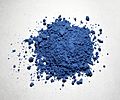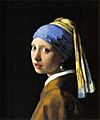Ultramarine facts for kids
| This box shows the colour Ultramarine. |
|---|
Ultramarine is a beautiful blue color and also the name of a special blue pigment. A pigment is a material that gives color to things like paint or ink. This amazing blue color comes from a natural mineral called Lazurite. Lazurite is the main part of a precious blue stone known as lapis lazuli. The unique blue shade of ultramarine is caused by tiny parts inside it called S−3 anions.
Contents
Natural vs. Man-Made Ultramarine
Ultramarine can be found naturally, but it can also be made by people.
Natural Ultramarine
Natural ultramarine pigment is made by grinding down the mineral lazurite, which is found in lapis lazuli. This process creates a beautiful, deep blue color.
Man-Made Ultramarine
Man-made, or "synthetic," ultramarine was invented in the 1820s. It's often a brighter blue than natural ultramarine. This is because the tiny particles in man-made ultramarine are smaller and more even in size. This helps them spread light more smoothly, making the color look more vivid.
Man-made ultramarine is very useful because it's not changed by light, oil, or lime. This makes it great for painting. It's also much cheaper than natural ultramarine.
How Man-Made Ultramarine is Used
- Painting: It's used a lot for painting walls and printing designs on paper and fabric.
- Making Whites Brighter: Have you ever seen white clothes or paper that look a little yellowish? Man-made ultramarine can be added in tiny amounts to make them look whiter and brighter. This is why it's used in "laundry blue" products for washing white clothes.
- Paper: Large amounts of it are used to make paper, especially the light blue writing paper popular in Great Britain.
- Airplanes: During World War I, the Royal Air Force (RAF) used a blue color based on ultramarine for the roundels (circle markings) on their airplanes.
Comparing Blue Colors
There are many shades of blue! Here's how ultramarine compares to some other blue-green colors. Each color has a special code (HEX Code) that computers use to show it.
| Name | Color | HEX Code | Red | Green | Blue | Hue | Sat | Lum |
|---|---|---|---|---|---|---|---|---|
| Green | #008000 | 0 | 128 | 0 | 120° | 100% | 50% | |
| Teal | #008080 | 0 | 128 | 128 | 180° | 100% | 50% | |
| Blue | #0000FF | 0 | 0 | 255 | 240° | 100% | 100% | |
| Ultramarine (Electric Ultramarine) | #3F00FF | 63 | 0 | 255 | 255° | 100% | 100% |
Ultramarine in Art History
Ultramarine has been a very important color for artists for centuries. Because natural ultramarine was so expensive, artists often used it for the most important parts of their paintings, like the robes of kings, queens, or religious figures.
-
The blue robes of the Virgin Mary by Masaccio (1426) were painted with ultramarine.
-
Pietro Perugino saved money on this painting of the Virgin Mary (around 1500) by using a cheaper blue, azurite, first, then adding a layer of ultramarine on top.
-
Titian used ultramarine in a dramatic way for the sky and clothes in his painting Bacchus and Ariadne (1520–23).
-
Sassoferrato's painting of the Blessed Virgin Mary, around 1654. Her blue cloak is painted in ultramarine.
-
Girl with a Pearl Earring, by Johannes Vermeer (around 1665).
-
Lady Standing at a Virginal, by Johannes Vermeer (around 1675).
Related Pages
Images for kids
-
Lapis lazuli stone (rough), from Afghanistan. This is where natural ultramarine comes from.
See also
 In Spanish: Azul ultramar para niños
In Spanish: Azul ultramar para niños












